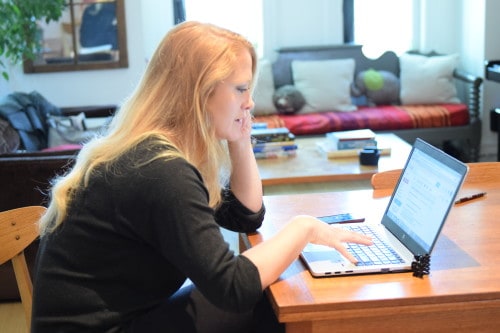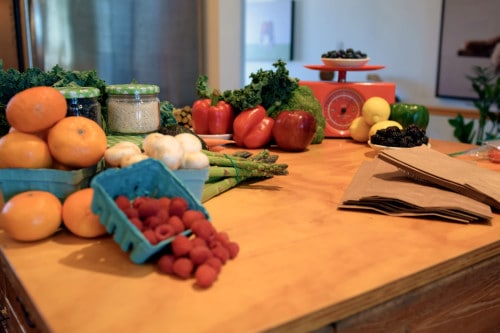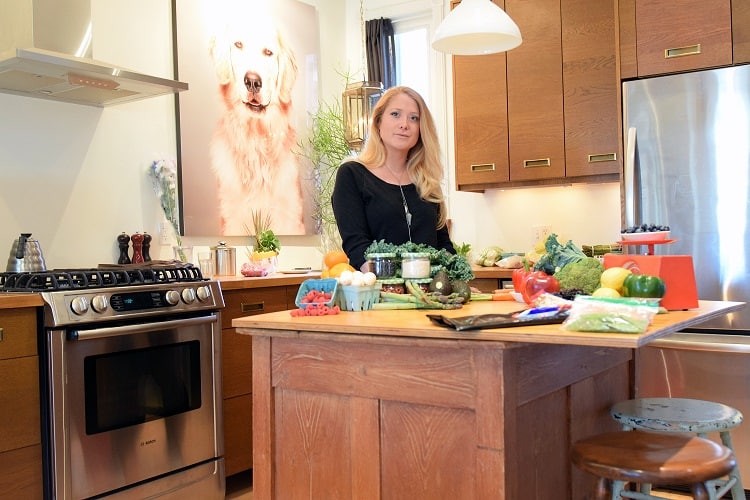Food insecurity—not having reliable access to affordable, nutritious food—is a very real problem in Toronto.
The numbers are staggering. The latest figures from Statistics Canada indicate that roughly some twelve per cent of Torontonians, and more than four million Canadians, experience food insecurity. Household food insecurity affects one in six Canadian children. Not having access to nutritious, fresh food on a regular basis has a significant negative impact on health, but while the price of food increases, incomes remain stagnant.
Three weeks ago, Kate Salter, a lawyer for Toronto Community Housing Corporation, was on Bunz Trading Zone and saw a post from a man looking for a banana or some other type of fresh produce. He wrote that he had peanut butter and tuna but, due to his financial situation, could not afford any fresh fruit or vegetables for a while and was craving something healthful.
Kate responded with an offer of a bag of fresh produce. She didn’t hear back from the man, but couldn’t stop thinking about him and his situation. Later that evening, she posted a note to Bunz offering to assist anyone experiencing unexpected food insecurity—due to a missed cheque, unexpectedly high bill or veterinary emergency, for instance—by providing healthy, homemade food and produce. She woke up to multiple requests for food—and even more offers to help.
We caught up with Salter last week
SDTC: Were you expecting such a big reaction to your post?
KS: No, not at all. But having volunteered in food insecurity relief efforts for most of my life, I had some idea of the general need.
It was only that day I really understood the volume of people who can benefit from discrete community food relief services in Toronto. For many reasons—including shame, transportation costs, mental illness, ineligibility and mobility challenges—many people do not benefit from traditional food relief services, such as a food banks or drop in meal centres. So I started offering to meet up with people—always at a TTC station for security—with a bag of produce supplemented with some prepared healthful foods. My boyfriend and I put together five “produce packs” for distribution. I arranged for the drop offs a day and a half later (thirty-six hours after the Bunz post went up) and posted a photo to Bunz of the produce packs.
The photo prompted a huge number of interest requests, so I set up an email to keep track of everyone asking for and offering help. One of the most touching aspects of the requests for help coming in is that in many cases people who were requesting food also offered to give back what they could, even though I indicated that no trade was expected or required.
The dignity that is created by making it an exchange rather than a donation prompted me to accept offers of help when they came. One professional photographer couple who received a pack took photos of their produce package for our website; another client will be helping me out in the garden I’ve planted to help supplement the produce packs.
By Tuesday (four days after the original post), I knew I needed a plan and help pulling it off. Tamara Kryugier-Baum, Shannon Candido and I built a core organizational team to give this initiative direction and support the development of a sustainable food relief service. Tamara has more than ten years of communications and project management experience with the federal government, and Shannon is a web design and online marketing strategist. We are also supported by the Bunz administrative team.

Kate Salter. Photo: Shannon Candido
What do your produce packs entail?
Each produce pack is different. We try to include leafy greens, apples, bananas, oranges, avocados, tomatoes, cucumber and bell peppers. It all depends on donations and what’s available at a good price if we are forced to purchase.
We supplement the packages with protein-rich prepared items when we can. We have been able to include some dairy products and vegan protein bars as they have been donated. And I have to confess, if there are children receiving the package, I can’t help but throw in a (mostly) healthy treat or two when I can.
What’s the plan now?
Well, for starters, we have a name! GoodFood Help reflects our desire to provide nutritious, fresh food to those who are experiencing temporary food insecurity in Toronto.
Our focus now is on addressing the influx of requests and evolving our initiative into a long-term, self-sustaining, discreet community response to temporary food insecurity where supply of fresh produce meets demand.
In the short term that means soliciting donations of food and financial support to put together packages for those on the waiting list and the requests that come in over the next little bit. We have a Go Fund Me page set up and while interest has been strong, the need is growing and we have found ourselves buying food to supplement our produce packs.
In the long term, we have started discussions with community members—including restaurants and the Leslieville Farmers Market—to secure reliable sources of quality produce. We also want to capitalize on the offers of help and volunteers that have come in. We have had offers of fundraisers, commercial kitchen space and professional and amateur cooking help. We’re working on a plan to bring it all together, engage all of the help we’ve been offered and continue to provide support to those having trouble accessing adequate healthy food to meet their needs. We hope to collaborate with existing food relief services in Toronto while developing a donation campaign, in order to establish a reliable and consistent flow of donations so we can make commitments to clients accordingly.
On the operations front, we’re looking forward to incorporating as a non-profit soon. We sort of fell backwards into this. Starting a non-profit wasn’t on any of our 2016 to-do lists, but clearly there is a need. We’re also looking for a few key volunteer members to join our core team, in particular a CPA-qualified treasurer, a volunteer coordinator and a food donations coordinator. Interested individuals can contact us at giving@goodfoodhelp.com. (I provide really good meeting snacks.)
On the very long term, we’re creating a model that can be replicated in chapters in different parts of the city, or in other cities, which would be wonderful.
The core focus (and what we believe to be a niche that we can fill) is the concept of discreet peer-to-peer delivery of fresh produce and healthful foods. We are developing a procedure to address requests on a weekly schedule, as well as emergency requests. We have filled two emergency requests this week and are building thresholds for how we respond to the same. We are organizing this initiative to become something sustainable because we’ve found a need and believe the discreet peer-to-peer model offers a unique solution to assist with established food insecurity relief efforts in Toronto.

Photo: Shannon Candido
What has the online reaction been like?
It has been incredible. I am awed by the outpouring of support, encouragement and the sharing of personal food insecurity experiences. I am also grateful that anonymity seems to be allowing those in need to come forward online and ask for support.
Using social media has been a really interesting experience because not many of the food relief services in Toronto (or elsewhere) are advertising their services in online communities. Bunz Trading Zone started because someone didn’t have any money for groceries and offered to trade something they had to offer in exchange for groceries. I did not know that when I posted my original offer but learned about the inception after the huge response my original offer ignited.
Have you ever experienced temporary food insecurity?
I have. There was a time in my life when I ate brown rice and plain yogurt for three weeks and submitted myself to medical testing for extra cash. There have been times when I worked in the service industry when the tips were slim, and my cheque wasn’t coming for two weeks and I had only $10 to spend on groceries. It’s a good thing I developed a taste for peanut butter sandwiches as a kid because they’ve gotten me through some tight times. When I was young, my parents did not have a lot of money and I remember a lot of rice and beans with the elaborate variation of either red sauce (ketchup) or brown sauce (soy sauce) to shake things up. Clear as day, I can remember my mom stirring a bucket of all-natural peanut butter with a 2×4.
What has surprised you most about this venture so far?
The things that cause people to need (a vet bill, a cancelled job contract, a new business that hasn’t quite taken off, fleeing an abusive situation) and the offers of help from clients. Having their offers accepted completely changes people’s demeanour. It’s so humbling.
How many people have approached you?
We have filled thirty-five orders and plan to fill an additional fifteen in the next week. We cannot make a firm commitment in these early days, but our goal is to have no client waiting more than five days, and no more than twelve hours in urgent situations.
We are also working on building relationships with the other organizations so we can refer clients who are in need when we are unable to assist.
What are the most asked for items?
People just ask for fresh things. We have also had specific requests for foods high in protein and kitchen staples (e.g., rice) if people find themselves without.
Why do you think people are reluctant to venture to food banks?
Because temporary food insecurity can impact anyone and often without notice—whether you’ve lived below the poverty line before or never have. Students on tight budgets, or people with unconventional employment arrangements facing an unexpected bill, or a person unexpectedly between contracts, are just not accustomed to accessing food banks for relief from food insecurity. In some cases our clients wouldn’t even qualify.
Many food banks don’t offer adequate, fresh food to meet nutritional needs so some of our recipients have gone there and asked for help from us. Mostly though I think it’s people’s perception of food banks. I have heard over and over again from those we are helping that they are sure there are others in more need than them, or they didn’t think that was the right place to go or that they really couldn’t face walking into a food bank. We offer fast, discreet, hands-off assistance in a neutral location. I think that goes far
Want to help? You can donate directly to GoodFood Help here. They’re also in need of a volunteer coordinator and a donations campaign coordinator (about a six-hour/week commitment). Contact Kate at bunz.feed.bunz@gmail.com for details. If you are living downtown Toronto and experiencing food insecurity, email requests@goodfoodhelp.com. All inquiries are confidential.
If you have ideas, want to donate, volunteer or just know you want to get involved, email giving@goodfoodhelp.com.



 Follow Us On Instagram
Follow Us On Instagram
